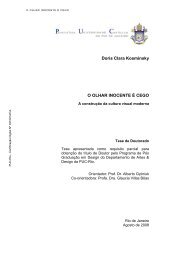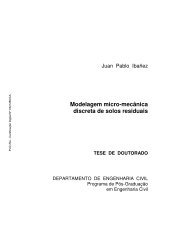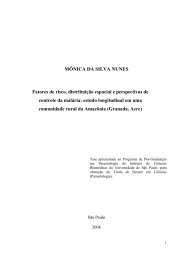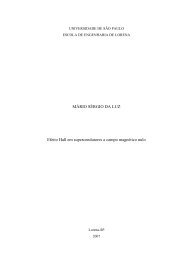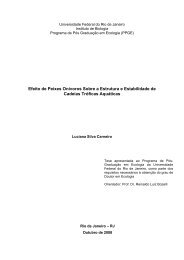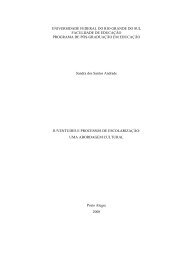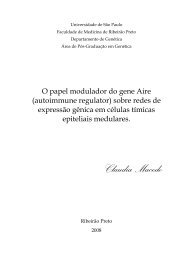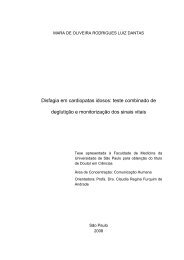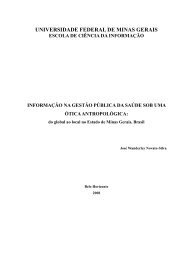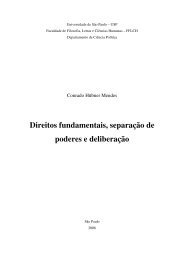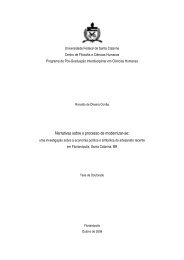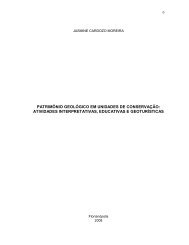Materiais moleculares funcionais contendo n-heterociclos - capes
Materiais moleculares funcionais contendo n-heterociclos - capes
Materiais moleculares funcionais contendo n-heterociclos - capes
You also want an ePaper? Increase the reach of your titles
YUMPU automatically turns print PDFs into web optimized ePapers that Google loves.
386 R. Cristiano et al.Table 3. Summary of photophysical properties of compounds1–7, in chloroform solution.Compoundl abs. max / l em. max /nm (e) a nmStokesshift/nmW PLb1 341 (4.0610 4 ) 395 54 0.8042 338 (4.0610 4 ) 395 57 0.8053 340 (4.0610 4 ) 395 55 0.8144 353 (5.2610 4 ) 389 and 413 c 36 0.5085 347 (4.6610 4 ) 406 59 0.8496 354 (5.5610 4 ) 460 106 0.5247 333 (4.3610 4 ) 366 c , 388and 407 c 55 0.754a Units5mol 21 cm 21 . b Determined using quinine sulphate asstandard (W PL 50.546 in 1N H 2 SO 4 ). c Shoulder peak.DSC analysis showed the presence of uniaxial nematicphase with typical schlieren texture in all compounds.Other mesophases observed were smectic C (for allcompounds except 1), smectic A (only for compound 6with a piperazine unit) and a unidentified smectic Xphase (exhibited by compound 7). Luminescenceproperties of the final compounds were evaluated.They exhibited strong blue fluorescence from 390 to460 nm with good quantum yields from 50 to 85%.Efforts to use these compounds for LED designing arecurrently under way.4. Experimental4.1. GeneralElemental analyses were carried out using a Perkin-Elmer model 2400 instrument. Infrared spectra wererecorded on a Perkin-Elmer model 283 spectrometer inKBr discs. 1 H and 13 C NMR spectra were obtained witha Bruker AC-200F spectrometer at 200 MHz and50.4 MHz, respectively, using TMS as the internalstandard. The melting points, thermal transitions andmesomorphic textures were determined using anOlympus BX50 microscope equipped with a MettlerToledo FP-82 heating stage and an exposure controlunit PM-30. DSC measurements were carried out usingShimadzu equipment with a DSC-50 module. A HitachiUV-Vis model 3000 spectrophotometer was used torecord absorption spectra. Fluorescence spectra wererecorded on a Hitachi-F-4500.4.2. MaterialsAll the reagents were obtained from commercial sourcesand used without further purification. Sonogashiracouplings were accomplished under Ar atmosphere.The intermediate 2-(4-bromophenyl)-5-(4-decyloxyphenyl)-1,3,4-oxadiazole(9) was obtained fromFigure 3. (a) Absorption and (b) fluorescence spectra ofcompounds 1–7 in chloroform solution.5-(4-decyloxyphenyl)tetrazole (8) according to a procedurereported previously [16]. The terminal acetylenes1-alcoxy-4-ethynylbenzene (10, 11 and 12), 4-decyloxy-49-ethynylbiphenyl (13) and 4-ethynylphenyl 4-decyloxybenzoate(16) were prepared according to publishedprocedures [26, 27]. The organic solvents were ofcommercial grade quality except THF (HPLC grade)and all were dried by traditional methods. In general, allthe compounds were purified by column chromatographyon silica gel (60–120 mesh), and crystallization fromanalytical grade solvents. The purity of the sample waschecked by thin -layer chromatography (MerckKieselgel 60F254).



